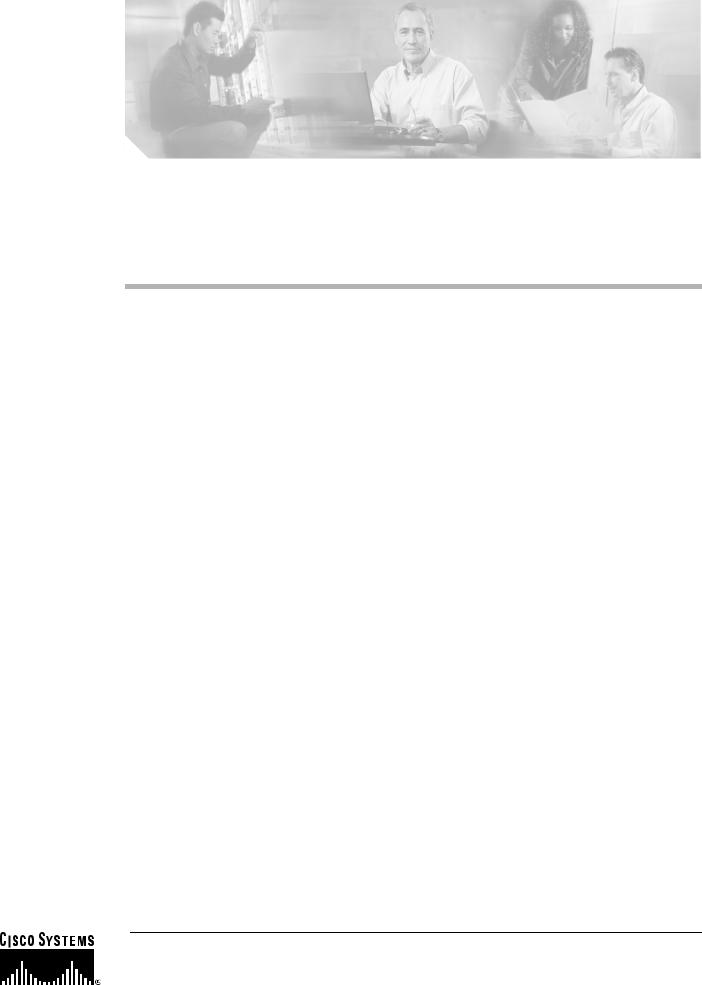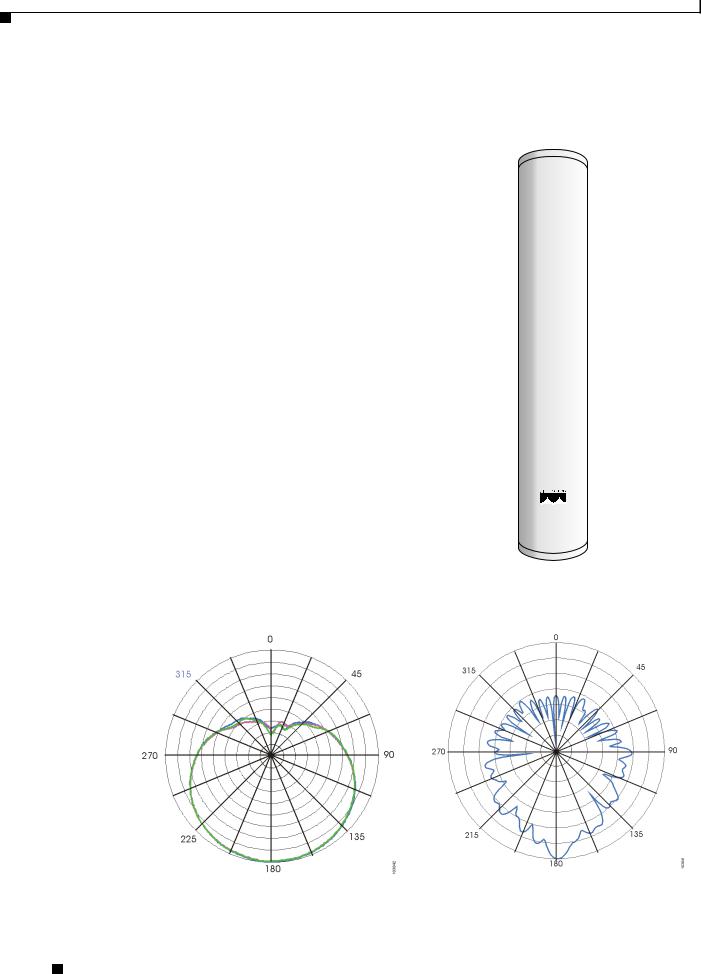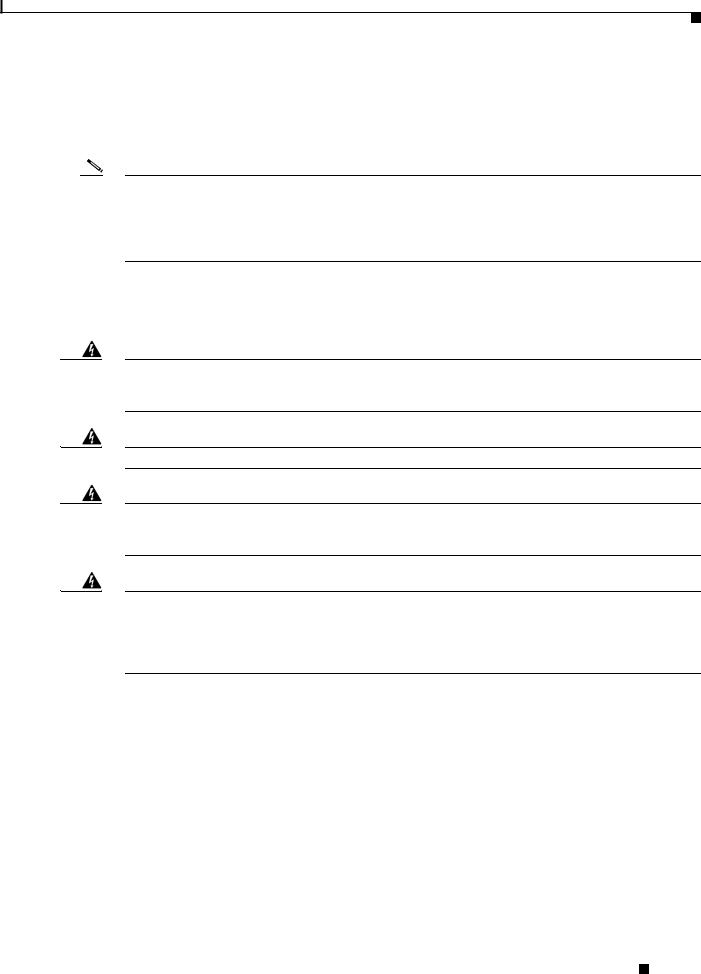Cisco Systems AIR-ANT2414S-R User Manual

Cisco Aironet 14-dBi Vertically Polarized Sector
Antenna (AIR-ANT2414S-R)
This document outlines the specifications, describes the AIR-ANT2414S-R 14-dBi vertically polarized sector antenna, and provides instructions for mounting and aligning it. The antenna operates in the 2.4-GHz frequency range and is designed for use in bridging environments. The antenna is designed to be used outdoors and can be mounted on 1.5 in. (3.8 cm) to 2.5 in. (6.3 cm) diameter masts.
The following information is provided in this document.
•Technical Specifications, page 2
•System Requirements, page 3
•Safety Precautions, page 3
•Installation Notes, page 4
•Obtaining Documentation, page 11
•Obtaining Documentation, page 11
•Documentation Feedback, page 12
•Obtaining Technical Assistance, page 12
•Obtaining Additional Publications and Information, page 14
Corporate Headquarters:
Cisco Systems, Inc., 170 West Tasman Drive, San Jose, CA 95134-1706 USA
Copyright © 2004 Cisco Systems, Inc. All rights reserved.

Technical Specifications
Antenna type |
90-degree sector |
|
|
|
|
|
|
Operating frequency range |
2400–2500 MHz |
|
|
|
|
|
|
Nominal input impedence |
50Ω |
|
|
|
|
|
|
2:1 VSWR bandwith |
2400–2500 MHz |
|
|
|
|
|
|
Gain (including 1.5 m cable) |
14 dBi |
|
|
|
|
|
|
Polarization |
Linear, vertical |
|
|
|
|
|
|
Azimuth 3-dB beamwidth |
90 degrees |
|
|
|
|
|
|
Elevation 3-dB beamwidth |
8.5 degrees |
|
|
|
|
|
|
Cable length and type |
5 ft. (1.5 m) |
|
|
|
LMR-195 coaxial |
|
|
|
|
|
|
Connector type |
RP-TNC Male |
|
|
|
|
|
|
Environment |
Outdoor |
|
|
|
|
|
|
Length |
35.9 in. (91.2 cm) |
|
|
|
|
|
|
Width |
6.4 in. (16.3 cm) |
|
|
|
|
|
|
Depth |
4.03 in. (10.23 cm) |
|
|
|
|
|
|
Weight (with hardware kit) |
7.5 lb. (3.4 kg) |
|
|
|
|
|
|
Operating temperature range |
–22°F to 158°F) |
|
|
|
(–30°C to 70°C |
|
|
|
|
117180 |
|
Storage temperature range |
–40°F to 185°F |
||
|
|||
|
(–40°C to 85°C) |
|
|
|
|
|
|
Wind rating |
100 mph |
|
|
|
(161 kph) |
|
|
|
|
|
|
H-Plane Radiation Pattern |
|
E-Plane Radiation Pattern |
|
|
|
|
Cisco Aironet 14-dBi Vertically Polarized Sector Antenna (AIR-ANT2414S-R)
2 |
78-16403-01 |
|
|

System Requirements
This antenna is designed for use with Cisco Aironet access points and bridges but can be used with any 2.4-GHz Cisco Aironet radio device that utilizes an RP-TNC connector.
Note To meet regulatory restrictions, if you are using this antenna with a Cisco Aironet 1300 Series Wireless Bridge, the antenna must be professionally installed. The network administration or other IT professional responsible for installing and configuring the unit is a suitable professional installer. Following installation, access to the unit should be password protected by the network administrator to maintain regulatory compliance.
Safety Precautions
Warning This warning symbol means danger. You are in a situation that could cause bodily injury. Before you work on any equipment, be aware of the hazards involved with electrical circuitry and be familiar with standard practices for preventing accidents.
Warning Do not work on the system or connect or disconnect cables during periods of lightning activity.
Warning This equipment must be grounded. Never defeat the ground conductor or operate the equipment in the absence of a suitably installed ground conductor. Contact the appropriate electrical inspection authority or an electrician if you are uncertain that suitable grounding is available.
Warning Do not locate the antenna near overhead power lines or other electric light or power circuits, or where it can come into contact with such circuits. When installing the antenna, take extreme care not to come into contact with such circuits, as they may cause serious injury or death. For proper installation and grounding of the antenna, please refer to national and local codes (e.g. U.S.:NFPA 70, National Electrical Code, Article 810, in Canada: Canadian Electrical Code, Section 54).
Each year hundreds of people are killed or injured when attempting to install an antenna. In many of these cases, the victim was aware of the danger of electrocution, but did not take adequate steps to avoid the hazard.
For your safety, and to help you achieve a good installation, please read and follow these safety precautions. They may save your life!
1.If you are installing an antenna for the first time, for your own safety as well as others, seek professional assistance. Your Cisco sales representative can explain which mounting method to use for the size and type antenna you are about to install.
2.Select your installation site with safety, as well as performance in mind. Remember: electric power lines and phone lines look alike. For your safety, assume that any overhead line can kill you.
3.Call your electric power company. Tell them your plans and ask them to come look at your proposed installation. This is a small inconvenience considering your life is at stake.
Cisco Aironet 14-dBi Vertically Polarized Sector Antenna (AIR-ANT2414S-R)
|
78-16403-01 |
3 |
|
|
|

4.Plan your installation carefully and completely before you begin. Successful raising of a mast or tower is largely a matter of coordination. Each person should be assigned to a specific task, and should know what to do and when to do it. One person should be in charge of the operation to issue instructions and watch for signs of trouble.
5.When installing your antenna, remember:
a.Do not use a metal ladder.
b.Do not work on a wet or windy day.
c.Do dress properly—shoes with rubber soles and heels, rubber gloves, long sleeved shirt or jacket.
6.If the assembly starts to drop, get away from it and let it fall. Remember, the antenna, mast, cable, and metal guy wires are all excellent conductors of electrical current. Even the slightest touch of any of these parts to a power line complete an electrical path through the antenna and the installer: you!
7.If any part of the antenna system should come in contact with a power line, don’t touch it or try to remove it yourself. Call your local power company. They will remove it safely.
8.If an accident should occur with the power lines call for qualified emergency help immediately.
Installation Notes
The antenna is designed to be mounted on a mast but can be mounted on most flat vertical surfaces. If you mount the antenna on a vertical surface using the mounting hardware provided, you can adjust the antenna’s elevation but not its azimuth. Therefore, the surface on which you mount the antenna must be oriented in the direction of the bridge link.
Choosing a Mounting Location
The antenna is designed to create a directional broadcast pattern. To achieve this pattern, mount the antenna clear of any obstructions to the sides of the radiating element. If the mounting location is on the side of a building or tower, the antenna pattern is degraded on the building or tower side.
Site Selection
Before attempting to install your antenna, determine where you can best place the antenna for safety and performance.
Follow these steps to determine a safe distance from wires, power lines, and trees.
Step 1 Measure the height of your antenna.
Step 2 Add this length to the length of your tower or mast and then double this total for the minimum recommended safe distance.
Caution If you are unable to maintain this safe distance, stop and get professional help.
Cisco Aironet 14-dBi Vertically Polarized Sector Antenna (AIR-ANT2414S-R)
4 |
78-16403-01 |
|
|

Generally, the higher an antenna is above the ground, the better it performs. Good practice is to install your antenna about 5 to 10 ft (1.5 to 3 m) above the roof line and away from all power lines and obstructions. If possible, find a mounting place directly above your wireless device so that the lead-in cable can be as short as possible.
Hardware, Tools, and Fasteners Required
A mast mounting installation kit is shipped with the antenna and consists of the following hardware.
•Upper mounting bracket (adjustable)
•Lower mounting bracket (fixed)
•Mast mount clamps
•Four 4.0-in. (10.1 cm) ¼-20 hex head bolts with flat washers, split lock washers, and hex nuts
•Four ¾-in. (1.9 cm) ¼-20 hex head bolts with flat washers, split lock washers, and hex nuts
•Four ¼-20 hex nuts with split lock washers
You will need two 7/16-in. deep well sockets or wrenches to install the antenna. Figure 1 shows the mounting bracket assembly.
Installation Process
The following sections contains typical procedures for installing the antenna on a mast. Your installation may vary. The process consists of the following procedures.
•Assembling the mounting brackets
•Attaching the mounting brackets to the antenna
•Mounting the antenna
•Aligning the antenna
•Grounding the antenna
Before you begin, refer to Figure 1 and Figure 2 to become familiar with the installation.
Assembling the Mounting Brackets
Two mounting brackets are provided; one is adjustable and the other is not. Figure 1 shows the adjustable bracket. The assembly process is the same for both brackets. Follow these steps to assemble the mounting brackets.
Step 1 Position the mast mount clamp plate inside the antenna bracket.
Step 2 Insert two ¼-20x ¾-in. hex head bolts into the holes in the mast mount clamp plate facing outward as shown in Figure 1.
Step 3 Place a flat washer and split lock washer on each hex head bolt.
Step 4 Start a ¼-20 hex nut on each hex head bolt and tighten hand tight.
Step 5 Place a flat washer on two 4-inch ¼-20 hex head bolts.
Step 6 Insert the bolts into the holes facing outward in the mast mount clamp plate.
Cisco Aironet 14-dBi Vertically Polarized Sector Antenna (AIR-ANT2414S-R)
|
78-16403-01 |
5 |
|
|
|
